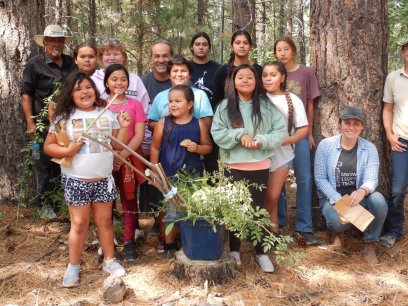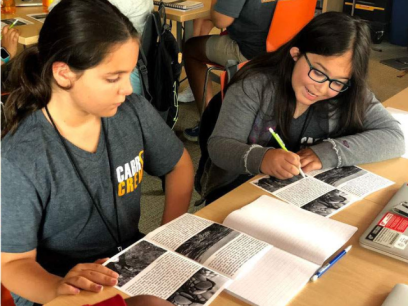
They say creativity breeds innovation, and nowhere is that more important—or encouraged—than in the field of STEM (science, technology, engineering, and math). However, STEM education often faces criticism for prioritizing calculation and analytics over arts and humanities, even though 91% of Americans believe the arts are part of a well-rounded education for K-12 students.

What role do the arts play in scientific analysis? Can creativity and calculation coexist?
Thanks to a partnership between the National Environmental Education Foundation (NEEF) and Arconic Foundation, students in Iowa’s Quad Cities region got to put these questions to the test while taking part in several Greening STEM projects that challenged them to think creatively while investigating environmental issues in their community.
Why is STEAM Important?
Art plays a major role in enhancing science learning. In fact, if you’ve been to a zoo or museum recently, you’ve likely seen this in action. It’s common for institutions to create models and illustrations to help visitors understand parts of the natural world that may be difficult to experience firsthand—such as using models to show what a jellyfish’s microscopic stinging cells look like up close.
This is where STEAM (science, technology, engineering, art, and math) comes in. Recognizing the importance of fostering creative thinking skills and ingenuity alongside technical proficiency, STEAM seeks to incorporate artistic pursuits into STEM learning, nurturing critical thinking and problem-solving abilities essential for students to excel in the modern world.

Art and science education are more similar than you might think. Both stress the importance of observing the world around us, whether you’re watching pollinators for a citizen science project or a still-life painting. Professionals in these fields also borrow tools and methods from each other when necessary; painters use scientific formulas when mixing colors to find the perfect shade, and engineers use artistic concepts of light and shadow when designing buildings.
However, STEAM isn’t merely STEM with a few dance classes thrown in. As Georgette Yakman, the founding researcher of the STEAM educational framework, puts it: “The liberal arts are the ‘who and why’ to the ‘what and how’ of STEM.”
What is Greening STEM?
Greening STEM is an interdisciplinary and collaborative approach that combines place-based environmental education, project-based learning, and community-based learning while adhering to the Next Generation Science Standards (NGSS).
NEEF partners schools, nonprofits, and public spaces to create immersive outdoor learning experiences for students, engaging them with STEM material by focusing on real-world challenges in their own communities.
Bettendorf Middle School in Bettendorf, Iowa, participated in two Greening STEM projects—one with seventh-grade students and the other with eighth-grade students—both focusing on fieldwork to restore the area’s natural prairie.

Environmental Education in the Field—or Prairie
The seventh-grade project revolved around prairie restoration. Students learned about the importance of prairie habitat in their local ecosystem, then visited a restored prairie to make observations based on what they found. They also visited a piece of land on the grounds of Eastern Iowa Community College in the very early stages of prairie restoration. In the end, they were able to give the land managers recommendations as to how they could continue their restoration.
The eighth-grade class used a stream that runs next to the Palmer Hills Golf Course in Bettendorf as a focal point for their lesson. They learned about watersheds and runoff, as well as water retention efforts in the area of the stream. They took a trip to the golf course to take water samples in the stream, talk to the course superintendent about fertilizers they use, and visited sites with a city water retention supervisor to talk about mitigation strategies for polluted water runoff.
Erin Allen, a seventh- and eighth-grade science teacher at Bettendorf Middle School, has been one of the project’s biggest champions from the beginning.
“There is no substitute for getting students out into nature when they are studying human impact on the environment,” said Allen. “Students saw firsthand some of the problems plaguing their local ecosystems and witnessed the complexity that goes into solving these problems. They were introduced to careers through the community partners involved, and were able to ask questions of experts in the field.”
Giving an “A” to Greening STEM
Normally, this is where a typical Greening STEM project ends. But this year’s project took things a step further.
In a new twist on the traditional project format, Bettendorf students were challenged to leverage their creativity to capture their classmates' outdoor learning experiences using digital storytelling. NEEF, with support from Arconic Foundation, worked with professional videographers to develop an online video journalism course for students to empower them to tell the environmental stories of their Greening STEM projects and inspire them in careers in both STEM and journalism.
The students shot their own footage, interviewed a handful of peers and teachers, scripted and recorded narration, and edited it all together with supervision from Allen and their professional mentors.
Nora Burns, one of the students behind the video, said she enjoyed the process of editing video clips together and learning more about her local environment by getting outside. “We learned so much about our local prairies and how they are important to us,” she said.
“I am very proud of the girls for their work,” said Allen. “I think we can impact more students through creative project-based learning programs like this one.”
Digital Storytelling Cultivates Critical Thinking Skills
As younger generations spend more and more of their time interacting with digital technology—especially during school hours—educators have searched for ways to use this to their advantage in the classroom. One method that is gaining steam (pun intended) is digital storytelling.
Digital storytelling is a project-based learning method that uses digital tools to tell stories in a visual way, typically using some mixture of graphics, text, recorded audio narration, video clips, and/or music. Students growing up in the age of social media have become very adept at recording and sharing their own stories using their phones, and through digital storytelling, they can use these skills to express themselves and their understanding of STEM concepts.
There is evidence that this method is effective throughout all levels of learning. A recent study found that the use of digital storytelling during science teacher education courses, as well as requiring students to create their own videos to explain concepts they had learned, led to higher assessed skill levels from new teachers entering the field of science education.
Robert Sendrey, program director for environmental education at NEEF, saw the Bettendorf project as an opportunity to expand the organization’s successful, established Greening STEM model to engage students in the material using digital storytelling.
“The video journalism course provided an additional opportunity for students to gain career exposure and experience while creating a product to share with their communities that showcases what they learned from the environmental education project they worked on,” said Sendrey.
Building a Culture of Creativity and Experience
Thanks to support from teachers, school administrators, and organizations like Arconic Foundation, the positive impact of this Greening STEM project has spread throughout the Quad Cities community and beyond.
The students’ work was presented at the local Iowa Science Teachers Conference in October 2022, attended by a dozen teachers from across the state. It was also featured prominently on the district website, presented to the school board, and covered in Bettendorf Magazine as one of the ten best things happening at the Bettendorf Community School District.
“Our teachers were given support, funding, and time needed to that made this project possible,” said Jayme Olson, director of curriculum and assessment at Bettendorf Community Schools. “Working out the logistics of these trips can be a daunting task the first time around. Now that we have developed a system for each model, understandings were made with administrators, parents, and among other teachers in the building as to the importance of getting students outside and a precedent has been established for future trips.”

Treya Patel, who also worked on the video, said she enjoyed the experience and hopes to get another chance to show her creative side on a similar project.
“I think I know more about my local environment because I got to help take a few pictures and go outside more,” she said. “I would recommend a project like this to other students because they get to explore the environment around them and learn how to make the ecosystem around them healthier.”

